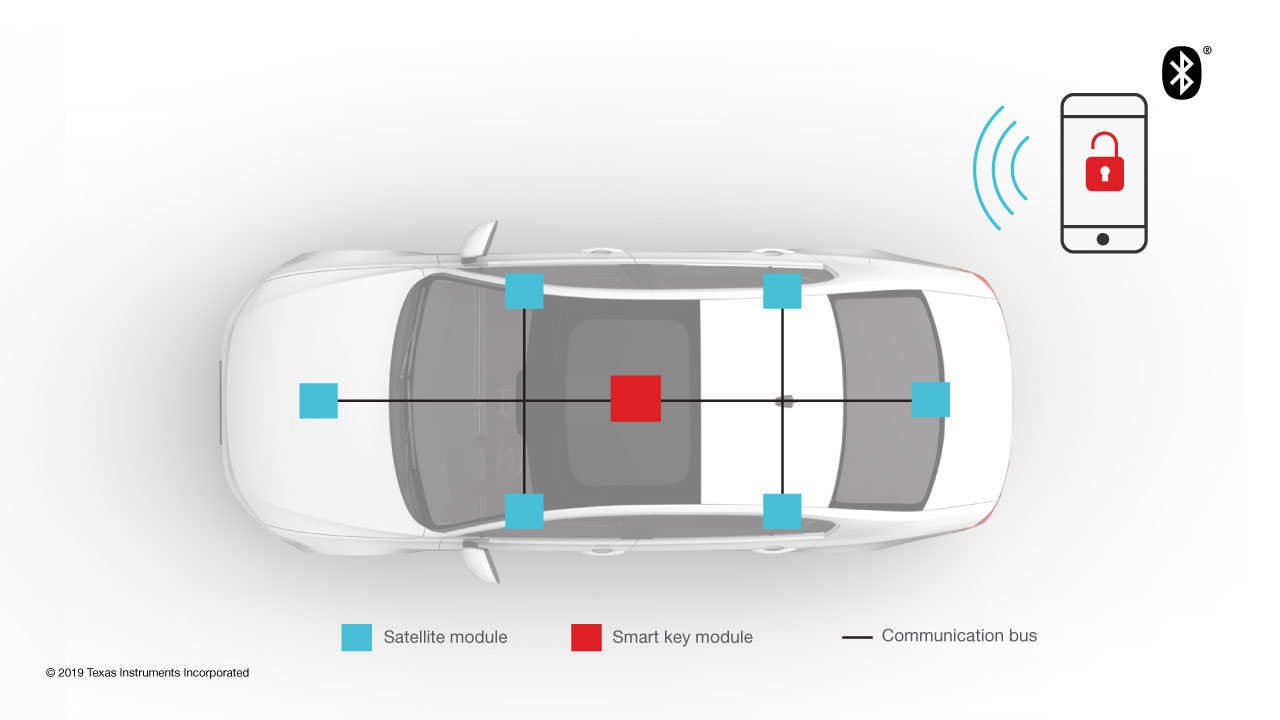SSZT439 July 2019 CC2640R2F-Q1 , CC2642R-Q1
The automotive industry is experiencing a tremendous transformation driven by consumers’ desire to leverage their phone as a key. By using phone-as-a-key, you can now eliminate the need for a traditional key fob in your passive entry passive start (PEPS) system. Bluetooth® Low Energy is a leading technology for this application because it is a versatile technology that is widely adopted in smartphones.
 Figure 1 PEPS Architecture in a Car.
the Number of Satellite Modules Will Vary, Depending on System-level
Requirements.
Figure 1 PEPS Architecture in a Car.
the Number of Satellite Modules Will Vary, Depending on System-level
Requirements.Let’s take a look at the Figure 1 above, illustrating the typical architecture of a car system that utilizes phone-as-a-key. It includes a central smart key module that communicates with the phone-key and several satellite nodes that passively monitor the Bluetooth Low Energy connection between the central module and the smartphone. TI’s automotive Bluetooth Low Energy car access satellite node reference design shows an implementation of such a node.
While there are multiple wireless technologies aiming to enable the phone-as-a-key solution, Bluetooth Low Energy is the most suitable technology due to several features:
- Low power – The power budget of modern connected cars is becoming increasingly tighter, especially when the ignition is turned off, as more and more electronic content is being added to the cars. As the result, low-power operation may be one of the key requirements for your car access system design. Since the car access system involves multiple nodes, the effect of the power consumption of a node is multifold for the overall system. Bluetooth Low Energy is particularly suitable for this type of always-on application due to its low power nature.
- Accuracy – Since the car access system must be reliable and accurate in various RF environments like crowded cities and underground garages, you must ensure that it is robust enough against multipath propagation. Multiple Bluetooth Low Energy anchors in a car access system can solve this problem by fusing data like Received Signal Strength Indication (RSSI), Angle of Arrival (AoA) and phase-based ranging acquired from various anchors. Multiple passive anchors (or nodes) also increase the degree of confidence in the measurements. Thus, Bluetooth Low Energy provides much-needed accuracy in reflective environments while increasing the robustness of your car access application.
- Wide adoption – Another challenge when designing a phone-as-a-key solution is to ensure the inter-operability of the car access system with the wide variety of smartphones out there. According to the 2019 Bluetooth market update report, 100% of the new smartphones shipments included Bluetooth technology. With its industry wide adoption, Bluetooth Low Energy has become the de facto standard for real-time location services (RTLS) using smartphones. The recent launch of direction-finding capabilities in the latest Bluetooth standard further enhances Bluetooth Low Energy as a key technology for localization applications like phone-as-a-key and PEPS.
With Bluetooth Low Energy, the possible enhancements to the user experience of your car access system are limitless. The user can simply walk up to the vehicle to unlock it with the digital phone-key and let the vehicle automatically adapt to the user’s preferred settings like the position of mirrors, seat, steering wheel and head up display using their customized digital profiles. Bluetooth Low Energy based car access systems can also enable your vehicle to utilize various secure ranging and localization techniques to locate the authorized phone inside the car, adding one more security measure before unlocking the doors and turning on the engine. Moreover, the user can create digital keys for friends and family as well as temporary digital keys for valet, making car sharing lot more convenient.
TI’s CC2640R2F-Q1 wireless MCU can enable you to utilize Bluetooth Low Energy in your car access system and eliminate the need of a traditional key-fob. For a larger memory option, check out the CC2642R-Q1 wireless MCU.
Additional Resources
- Watch the video, “Localization with Bluetooth”
- Download the Bluetooth Low Energy Car Access Systems – Tech Day from Detroit Tech Day.
- Read the short technical article, Adding CAN nodes in Bluetooth Low Energy PEPS systems.